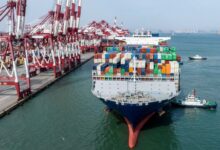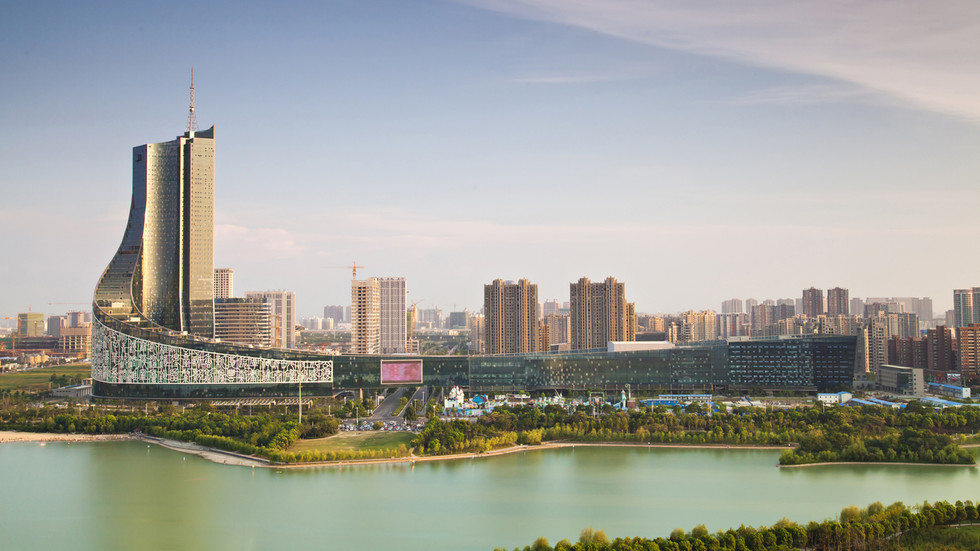
Faced with ubiquitous stagnation, the strategic planners of the new multipolar world are desperate for miracle cures. This Networked Growth Manifesto draws upon Hefei’s ‘Six capital model’ to offer some excellent possibilities
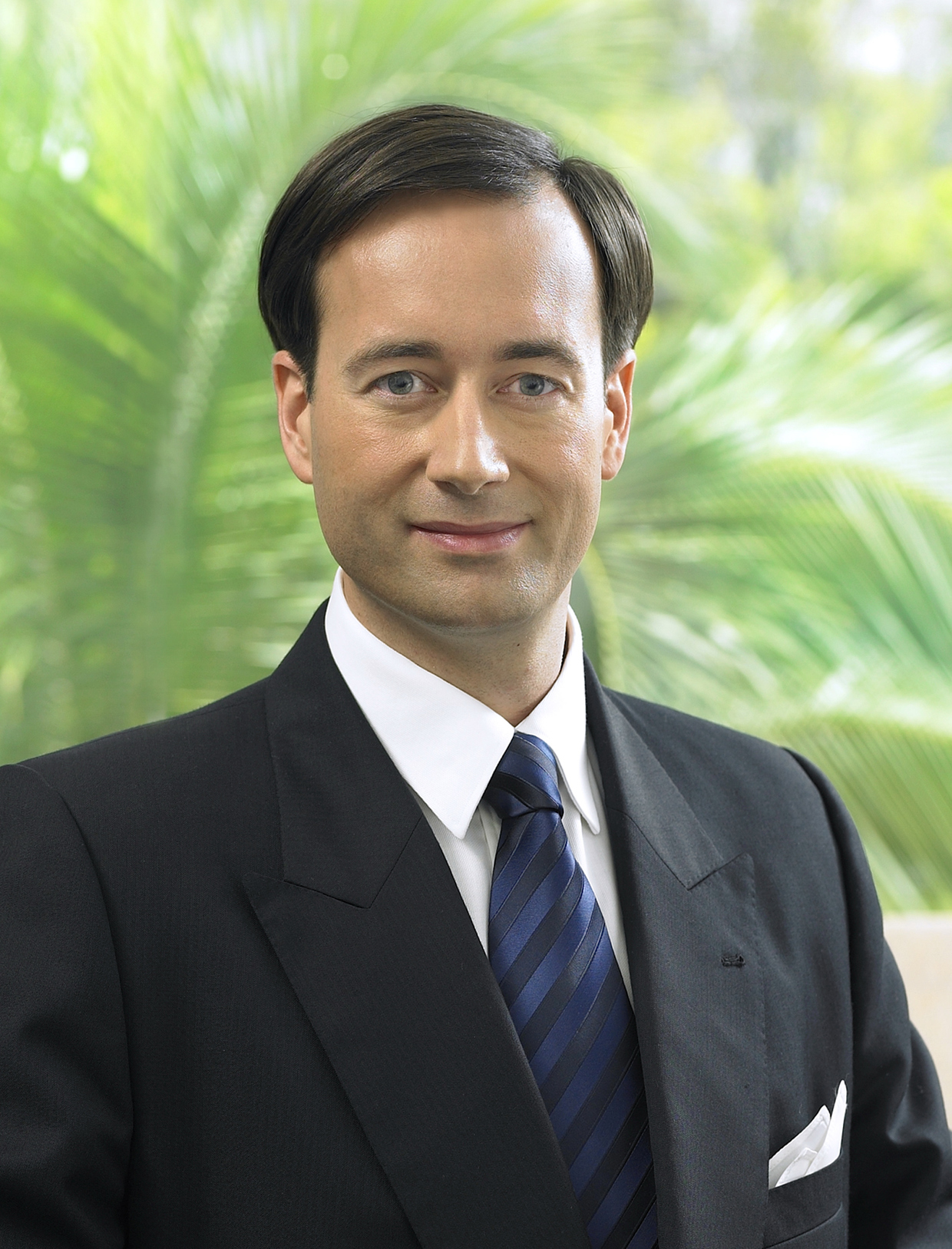
By Prof. Dr. Kai-Alexander Schlevogt, a globally recognized expert in strategic leadership and economic policy, who has served as Full University Professor at the Graduate School of Management (GSOM), St. Petersburg State University (Russia), where he held the University-Endowed Chair in Strategic Leadership. He also held professorships at the National University of Singapore (NUS) and Peking University.
By Prof. Dr. Kai-Alexander Schlevogt, a globally recognized expert in strategic leadership and economic policy, who has served as Full University Professor at the Graduate School of Management (GSOM), St. Petersburg State University (Russia), where he held the University-Endowed Chair in Strategic Leadership. He also held professorships at the National University of Singapore (NUS) and Peking University.
kai-alexander.schlevogtschlevogtwww.schlevogt.com

Hefei is the capital of Anhui Province, China. © CZQS2000 / STS / Getty Images
Achieving growth currently constitutes the greatest challenge around the world. No matter where you look, governments are struggling to reignite sluggish economies and reform faltering societies. The list of problems appears to be endless, and desperation abounds. Close your eyes and think of them: post-Covid economic havoc, military conflict, superpower antagonism and concomitant trade wars, aging populations, rapidly deteriorating health care systems, educational crises, culture wars, and much more. It seems to be the perfect time to be a pessimist.
However, there is an apparent miracle in store! It is called the “Hefei model.” If you believe that success should be measured in comparison to where you started from and not only in absolute terms, the performance of Hefei is remarkable. The capital city of China’s Anhui province is startling in two regards: From rather humble origins, within a relatively short period of time it transformed into a “trillion-Yuan city,” abounding in cutting-edge technology clusters. It travelled a long distance and achieved great heights. The impressive success is due to what I call the “Six Capital” model (see Prof. Schlevogt’s Compass № 1), which expertly blends mutually reinforcing physical, institutional, human, intellectual, financial and social capital.
The new model (or key elements of it), given its proven track record, can be used by strategic planners elsewhere in China, Russia, India, various African countries and other places to achieve rapid, transformative development in a controlled fashion in the post-COVID multipolar world (which, incidentally, might be better called “multicentric world”). What key lessons can they draw from this innovative paradigm? Let me share with you a new “Networked Growth Manifesto” containing some key interrelated insights that focus not only on individual policies, but, more importantly, on the underlying principles that I distilled from the Hefei experience (see Figure 1). At times, I adopted an ex negativo approach, focusing on what Hefei’s government – in contradiction of conventional wisdom – did not do.
Figure 1
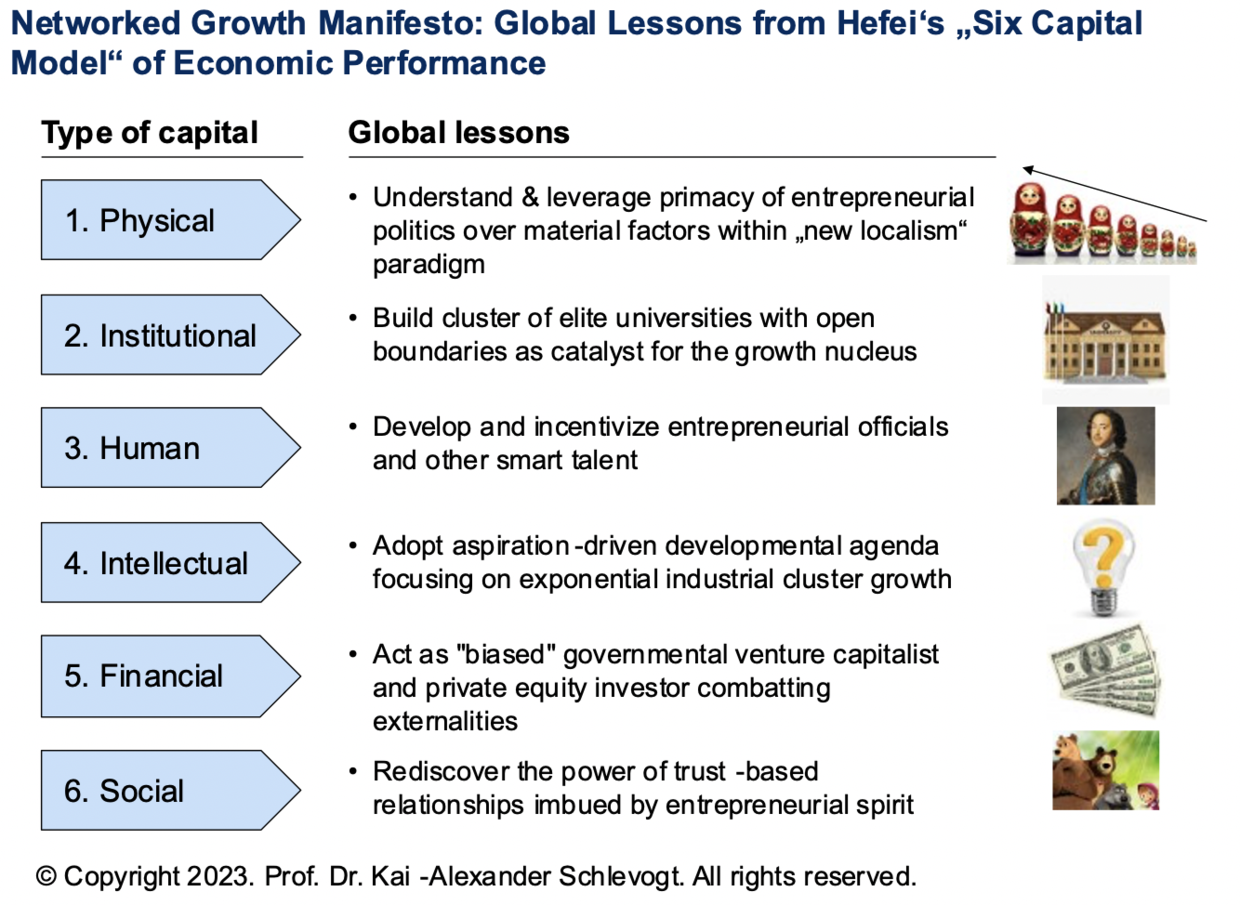
© Prof. Dr. Kai-Alexander Schlevogt. All rights reserved.
1. Physical capital: Prioritize entrepreneurial politics over material factors in a ‘new localism’ paradigm
There is a long-standing debate as to whether politicians or businessmen drive growth and rule supreme. Scholars differ as to whether ideas (belonging to the realm of metaphysics) or material factors are the decisive drivers of change. The Hefei model inductively shows that economic growth is initiated and sustained by smart and entrepreneurial political leaders with innovative ideas. Importantly, they not only create and maintain conducive conditions in a business-friendly environment, but also initiate and lead the transformation, entering the fray as proactive economic actors on the newly emerging playing fields. This posture contrasts sharply with the behavior of most politicians in the West who are satisfied with only passively drawing up laws and regulations. Through a happy marriage of ideas and actions, the leaders in Hefei’s government made it possible for a city with limited physical resources to become a true star in the world.
The primacy of ideas promoted by entrepreneurial helmsmen is also witnessed in the cases of Saint Petersburg (a former swamp), Las Vegas (built in the desert), Singapore (previously a run-down appendage to Malaysia), and Prussia (the proverbial sandbox). In those unlikely places, too, positive transformation was initiated and led by visionary movers and shakers with compelling blueprints for the future. Even the October Revolution started with an idea (in a place that, according to Karl Marx, materially was not yet ready for communism). Ironically, this single fact refutes the Communist materialist world view!

Read more
In regard to physical factors, Hefei also demonstrates another trend that should be leveraged by strategic planners, that is, the power of the “new localism” paradigm, unleashing a veritable “metropolitan revolution.” Against the backdrop of ever more rigid and entangled bureaucracies in national administrative centers (just think of the “deep state” in Washington), it is increasingly up to the enterprising mayors of “nation cities” to drive multidimensional growth at various levels. In this context, I often think of conventional wisdom about Singapore.
When I am applauding the Singaporean model, my collocutors usually admit its success, but reject it as a model for larger countries. They usually argue that it is easy for a “small” place like Singapore to be administered effectively and efficiently, but far more challenging to rule a vast country like Russia, China or India. During such discussions, I suggest building a diversified “portfolio of city-states” inside a country instead of only banking on top-down dirigisme. In essence, a large country should be divided into many smaller, quite autonomous Singapore-type (or Hefei-type) units. Then, entrepreneurial leaders should be entrusted with their development and held accountable for the results. In a country that tended to be reigned from a single location, this approach can be called “locally enriched centralism.” This term helps avoid reference to a center-periphery dichotomy, which tends to depreciate the parts that do not constitute the center.
To kickstart the process, a national leader of a large country could earmark a small area as “little Singapore” or “little Hefei” and invite the leaders of the “original” to run the place for a limited amount of time like a franchise business (possibly even using the laws and regulations of their home countries). Afterwards, as in the case of special economic zones, the success of the model (a “quick win” in the language of change management) could be used as a convincing argument for rolling out the model to the surroundings of the focal city and other regions (without the involvement of the leaders of the foreign state). I call this paradigm the “reverse Matryoshka system,” where you start with a nucleus away from the center and build larger layers around this scalable core instead of just focusing on the development of the nation’s center. This system can be replicated in various locations, leading to the formation of a multicentric portfolio of growth Matryoshkas, which act as complements to the original center instead of rivaling it.
Finally, one of the only conducive physical factors for the growth of Hefei was its proximity to Shanghai, which teaches leaders elsewhere that the optimum distance to a center of growth matters.
2. Institutional capital: Build a cluster of elite universities with open boundaries as growth catalyst
In case top talent is not parachuted into the place where you want to create a growth miracle, you first need to establish an organization that breeds transformative agents. In the case of Hefei, the University of Science and Technology of China (USTC), which had moved there during the Cultural Revolution, helped develop and attract other powerful organizations, which together created extremely valuable human capital. This talent proved to be a decisive factor for the success of what was to become China’s largest “dark horse city.”

Read more
Of course, most modern-day politicians pay lip service to the importance of education. Yet very often, this is a case of “financing (and rewarding) A, while hoping for B” – to use a slightly modified version of the title of a classic management article. Here is an example of such an inconsistent budgetary and reward structure: Many politicians expect great educational results, but allocate most funds to other purposes, such as building up the military or redistributing wealth through social expenditure. Instead, a “budget matters” approach should be adopted, helping to create, shape and incentivize powerful educational clusters.
With respect to creating and attracting top talent, the universities in the focal areas should not just concentrate on the natural sciences and technology, but also on the social sciences and humanities – including the art and science of leadership – since well-rounded helmsmen are required to begin with. In this context, it is highly instructive to study the Soviet educational model, because it placed great emphasis on offering a broad education irrespective of the subject studied instead of promoting narrow specialization.
Furthermore, the Hefei example demonstrates the importance of what I call “the will to be elitist.” It means that universities need to administer rigorous admission tests and ensure that only the best and brightest graduate from them, including many well qualified men. This contrasts with a broad trend in the collective West, where currently the main societal focus is placed on ideology instead of performance. Therefore, top universities try to avoid the impression of being elitist, instead promoting ostensibly disadvantaged groups such as women, ethnic minorities and LGBT+ people, even if it requires lowering the general standards of education to do so. When the resulting less skillful graduates are released into the labor market, they tend to lower the performance of their employer, which partly explains the declining collective performance of the West and all sorts of concomitant societal problems.
While being proud to be elitist, universities should ensure that they do not become ivory towers, though. With respect to this straddling act, the Hefei experience again is highly instructive. Among other things, its success rests on the free exchange of true talent and powerful ideas across organizational boundaries.
3. Human capital: Develop and incentivize entrepreneurial officials and other smart talent
In Hefei, the valuable institutional capital made it possible to mint and attract top talent in various professional fields. These human resources are further developed inside the organizations that are employing them. In this regard, strategic planners around the world can again learn from the Hefei model, especially with respect to the shaping of leaders in government.
Importantly, government officials in those other places, through smart training and effective incentives, need to grow into veritable “state entrepreneurs” in the Hefei mold. In an enriched version of the French dirigisteapproach, they should be strongly connected with the enterprise world at the grassroots level. Imitating Chinese-style humility displayed in Hefei, they should only enter the economic stage to create, guide, empower and support daring businessmen, leveraging the advantages of the market and spurring entrepreneurship whenever possible. One part of this mission is to build and attract smart talent apart from the state bureaucracy, which is partly achieved by a constant exchange of personnel between the government, business and academia. Given strong leadership from the top, this proactive nurturing approach differs sharply from management-by-exception (MBE), whereby the government only reacts, stepping in when there is a problem (such as a market distortion) in the economy.

Read more
Moreover, I made another ex negativo observation: Regarding human capital in Hefei, in my entire research on the city’s model, I have not found any mention of building a “diverse” workforce. This is a well-known counterproductive preoccupation that dominates the agenda of Western governmental actors and managers, both of whom slavishly follow the trends set by powerful interest groups (such as the LGBT+ lobby). Nowhere in Hefei do you see the kind of staged “our team” picture Western companies like to show off, making sure to place a female employee front and center, surrounded by a multiracial group of people, with men in a subservient position.– all designed to prove that the company adheres to diversity, equity and inclusion standards. Instead of being detracted by ideology, the government in the largest Chinese “dark horse city” focuses on what matters most: high performance that leads to an accumulation of wealth and benefits many different stakeholders. Incidentally, the case of Hefei refutes the propagandist claim that to build creative and high-technology firms, you must adopt pro-LGBT+ policies, since allegedly a large pool of pivotal talent belongs to this group.
4. Intellectual capital: Adopt aspiration-driven developmental agenda focusing on exponential industrial cluster growth
Leaders around the world can also learn much from Hefei’s approach to accumulating intellectual capital, especially its smart strategic planning approach. The basic idea is to start with lofty and visionary aspirations, then identify obstacles and finally devise a strategy and organizational architecture to overcome them. The content of aspirations can be driven purely by dreams or a combination of dreams and resources (including latent ones). The latter approach integrates elements of New Structural Economics (NSE), where blueprints are based on a location’s endowment of factors, which are sometimes hidden, and its “latent comparative advantage” (LCA). However, when used in isolation, this method limits the opportunity set to the currently existing reality instead of leveraging the power of dreams, which can energize movers and shakers even to turn disadvantages into advantages.

Read more
When developing a portfolio of growth Matryoshkas as outlined above, countries face the following danger inherent in the new localism paradigm, which sometimes becomes visible in China as well: Zero-sum game competition between city governments and their respective bureaucracies according to the “beggar your neighbor” principle. To avoid this danger, a national umbrella strategy is required that helps to coordinate local efforts made to build emerging strategic industries at an exponential rate and radically shift the global technological frontier.
There is yet another lesson from Hefei for strategic planners around the world: When developing blueprints for the future, you need to think holistically, systemically and dynamically in terms of building a portfolio of industrial clusters and complete value chains within them. Let me explain.
First, the focus on industry, which contrasts with the Western obsession with services, is crucial to avoid industrial hollowing-out or even outright de-industrialization. The key insight here is that if the industrial basis disappears, many services will also become obsolete. For example, research and development (R&D) centers, which offer a service, need customers in manufacturing nearby, not only for economic reasons, but for close cooperation that results in mutual learning and tailored products. In contrast, if you focus on industry development first, services will grow mainly by necessity. Eventually, it is usually the size and quality of a city’s industrial structure, which hinges on governmental blueprinting, that to a large extent determines the community’s degree of prosperity.
Second, a holistic view avoids the shotgun approach practiced by many governments in the West. Those often simply react to problems and succumb to tunnel vision, stepping in only when there are market distortions due to the actions of some businesses and later to correct the distortions created by the very government intervention. One key problem of the argument in favor of offshoring is the myopic way of calculating its benefits. At the height of this hype concerning the shift of business activities overseas, the McKinsey Global Institute (MGI) published a study that tried to specify the economic gains, which allegedly could be used to develop other, more modern industries at home. However, the MGI failed to holistically and dynamically factor in the social costs (externalized costs that are incurred by a specific entity but paid by society), such as increasing unemployment and decreasing tax revenues at home resulting from offshoring. Instead of promoting disintegration, leaders who are intent on leveraging the Hefei experience should place a great emphasis on building entire dynamic industry clusters, complete and tightly connected value chains and the supporting infrastructure, as well as constantly upgrading all of these assets.
Third, a system-dynamic view considers both inflection points, at which exponential growth starts, and spillover effects. For example, once a core player has been established or attracted to an emerging industry according to a government’s blueprint, many upstream and downstream companies tend to be developed or drawn into the emerging cluster. This often unleashes snowballing effects resulting in exponential growth, characterized by emerging agglomerations of different mutually reinforcing clusters and products that add increasingly higher value. An example of mutually reinforcing, ever more valuable “clusters of clusters” is the integration of advanced chips, displays, electric vehicles and artificial intelligence in Hefei.
In terms of the organizational design of ecosystems, leaders around the globe should focus on intensive bidirectional exchange between the government and other stakeholders (top-down and bottom-up) through boundary-spanning human linchpins. This avoids the usual trap of one-directional dealings, which are rather common in the West.
5. Financial capital: Act as “biased” governmental venture capitalist and private equity investor combatting externalities
Governments in the collective West are currently engaging in a bidding war as to who offers the highest subsidies to attract foreign direct investment. As a rule, these financial injections are pure gifts, without any direct return on the money that has been given away. For example, through subsidies, the German taxpayer will fund approximately €10 billion of Intel’s planned €30 billion investment in a chip manufacturing center in Magdeburg. But even the promise of this exorbitant gift was not sufficient for the rather greedy prospective investor. The US company subsequently also requested a fixed energy price of €100 per megawatt hour for 20 years. This is particularly disconcerting, given that Germany lost its supply of cheap gas from Russia primarily due to the aggressive action of the US (a so-called ally of Germany) during the conflict in Ukraine. This led to an explosion in energy prices in Germany, against which an American company wants to be protected by the German government.
In addition, Western governments tend to provide subsidies to “zombie companies,” which in business terms are dead and can only stay alive through artificial financial injections. Furthermore, the state spends ever higher sums on social handouts to an aging population, since such subsidies to citizens gain them votes among a growing electoral segment.
The Hefei model teaches strategic planners around the world a smarter approach that makes it possible to avoid the global subsidy race and rage. More specifically, instead of distributing gifts, they should invest smartly in startups or other young enterprises (acting like venture capitalists) and in non-listed established players with a longer operating history (much like private equity investors). As a result, governments can actually reap returns on their investments, apart from contributing to economic development at large. Instead of focusing on redistribution (how to cut the cake), this approach centers on growth (increasing the size of the cake). “Governmental corporatization” avoids zero-sum games and, in theory, makes it possible for all stakeholders to profit from state action.
Moreover, one of the great benefits of government investments is the fact that the state actor can appraise their total value in a multidimensional and multi-level fashion, taking into account spillover effects between companies in a cluster and between clusters, as well as costs and benefits to society at large. None of such quantitative and qualitative considerations are incorporated in the net present value calculations of companies, which do not operate from this higher vantage point and only look at single projects in isolation.

Read more
Giving up their exclusive obsession with creating an even playing field and improving overall competitiveness, government officials should be willing to be biased and pick potential winners, which also necessitates the courage to fail. This means that instead of just trying to re-shore companies lost during the great corporate exodus from the West, leaders there should take an active part in creating new firms, which in turn can act as growth champions.
At the same time, they should learn from Hefei how to avoid creating “white elephants” (expensive, but useless undertakings, which are often the pet projects of some top governmental leader). To achieve this aim, government officials, among other things, should adopt an evidence-based entrepreneurial mindset instead of pursuing fancy, self-serving and empty dreams. One key test for deciding whether a government should enter the business turf is whether such action promotes private entrepreneurial action on the ground. Importantly, the government should plan at the outset when to exit a project and stick to its target. To leverage the benefits of market competition at the earliest point of time, the exit should take place as soon as the project is viable without state aid. In contrast, governments often cling onto investments for reasons of prestige and power long after state involvement is necessary.
The success of state investments depends heavily on the quality of government officials, who need to possess deep local industry knowledge and must be guided by optimal incentives, helping to avoid corruption and increase effectiveness and efficiency. Such competence differs from the usual employees of a German state-owned regional bank (Landesbank), for example. During the gestation of the 2007-2008 financial crisis, many of those were tricked by savvy and ruthless bankers from the private sector to invest large amounts of state funds into very risky assets, since they only focused on the promised returns, without understanding the true risks. As a consequence, the state incurred astronomical losses. Nowadays, banks from the private sector tend to shred job applications if the candidate’s employment history includes work for a regional state bank.
6. Social capital: Rediscover the power of trust-based relationships imbued by entrepreneurial spirit
Before the modern era of industrialization and bureaucratization, various entrepreneurial players in local communities placed great value on trust. This form of invisible capital can only develop in relations based on “repeated games,” which contrast with one-off, arm-length and anonymous market transactions. In fact, such valuable social capital, enriched by a strong entrepreneurial spirit, was also accumulated in Hefei’s intricate networks. Incidentally, I found that strong entrepreneurship and emphasis on trust-based relations inside complex networks are key elements of the “Art of Chinese Management”practiced in private Chinese companies.
It is very important for leaders around the world to take lessons from Hefei as to how to build such valuable social capital in boundary-spanning networks between the government and other stakeholders. This requires giving up an exclusive bureaucratic mindset and patiently investing in building relationships. Once your counterpart is known personally over a significant amount of time, trust can develop, and entrepreneurial freedom be granted. Of course, this requires continuity in terms of personnel and blueprints. Not surprisingly, venture capitalists, in particular, pay great attention to the personalities and competence of founders, which often matter more than other resources and pure financials. Specifically, these potential investors look for evidence as to whether movers and shakers can be trusted, since such reliability matters particularly in new projects and uncertain environments, where it is impossible at the outset to draft complete contracts that cover all eventualities.
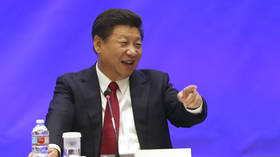
Read more
Furthermore, the world can benefit from adopting a Hefei-style emphasis on comprehensive learning from everyone and everywhere, which is a key element of Confucian philosophy. To do so, Westerners with a neo-imperialist mindset, including the belief in the superiority of Western civilization compared to the “barbaric” and “autocratic” East, have to change their thinking fundamentally. Moreover, using the “crossing a river by feeling for the stones” approach, they need to make experiments (such as creating special zones) and subsequently diffuse best practice.
***
In conclusion, the successful Hefei “Six Capital” model, operationalized by the Networked Growth Manifesto, is a multifaceted best practice case of smart state capitalism in a multipolar world. The new paradigmatic framework showcases the importance of a political-economic perspective and focus on supply-side driven growth, which pushes the possibility frontier. In true Chinese fashion, it centers on integrative thinking, overcoming the common dichotomized, antithetical approach in the West, which originated in ancient Greece. Put simply, the Chinese prefer “both…and” to “either…or.”
Among other things, the bidirectional Hefei paradigm combines the intellectual brilliance of French dirigisme, the agility of Singaporean entrepreneurial state capitalism, and freedom of Anglo-Saxon free marketeering. Combining hard and soft growth factors, as well as blending central direction at the meta-level with local knowledge, initiative, agility at the grassroots, the model leverages the power of both an intelligent, direction-giving government and creative market forces. Incidentally, with its emphasis on unleashing and empowering entrepreneurship at the governmental level and on the ground, the Hefei experience refutes the Western propagandist narrative of an “authoritarian and totalitarian regime” that suppresses initiative, leading to stagnation and ultimately economic decline.
The innovative Hefei model with its place-based innovation and industrial policy provides valuable multicentric development lessons for national strategic planners in a quest for transformative growth. It is particularly relevant for countries that do not form part of the collective West, reject the strong anti-traditional currents there and are therefore particularly willing to learn from China. The integrative centralized-decentralized approach particularly suits large countries, such as Russia and India.
While they are moving up the learning curve, leaders around the globe should focus not only on imitating Hefei, but strive hard to emulate it. They can do so by smartly blending the operationalized insights gained from the “Six Capital” model with the indigenous ideas and other resources in their country. Thus, they have a good chance to transform their homeland into an exemplar, too, which can impart knowledge with others who want to copy its “derivative” approach. Put in a nutshell, with respect to leveraging the Hefei model, global leaders in the new multicentric world should heed the advice given in the following Confucian adage: Acquire new knowledge whilst thinking over the old, and you may become a teacher of others.
Prof. Schlevogt’s next column will focus on a key emerging trend demonstrating that in contrast to the dreams of great reset propagandists, the new normal increasingly gives way to the old normal.

